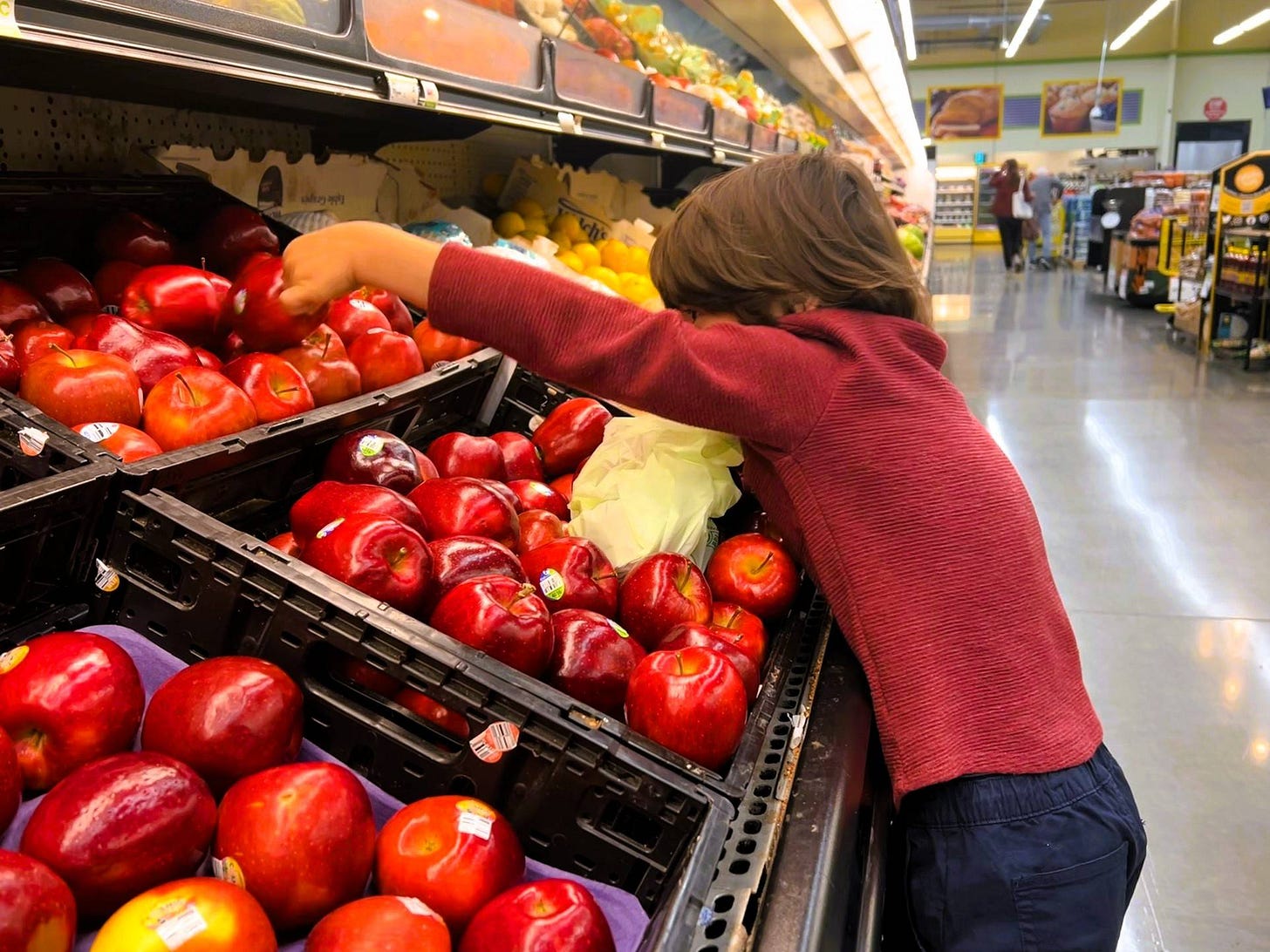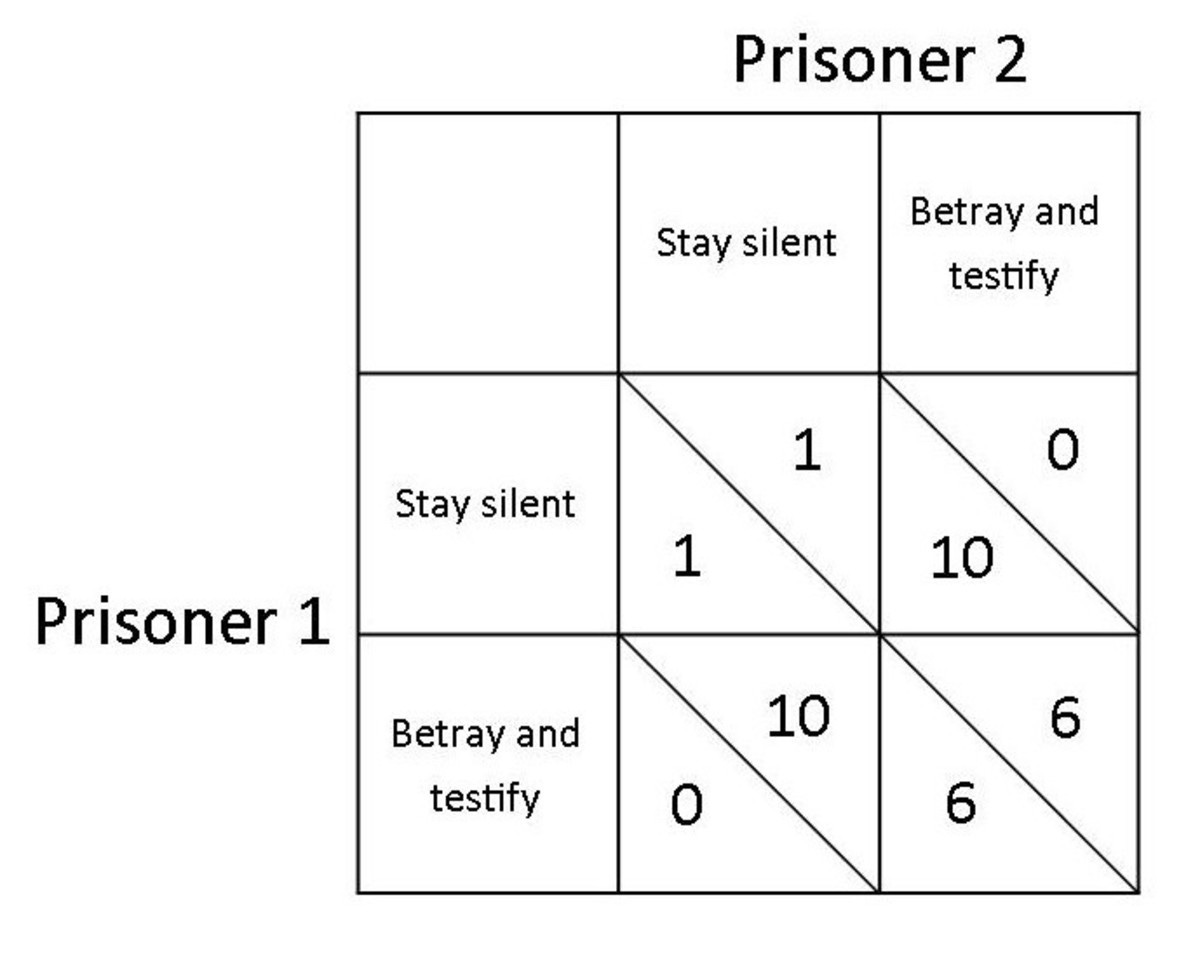1 Family Photo:
Strategy
What's a proper produce picking strategy?
Pick low hanging fruit first or last?
--
How do you teach strategy? How do you learn strategy? What is strategy?
We played board games with Calvin and Lawrence this week. Candyland and Sorry don't have a lot of strategy—just following the rules long enough to complete a game feels like success. Most games end with someone announcing they're bored or someone knocking pieces off the board. In fairness, that can be a strategy of sorts.
--
Game theory is the study of strategy. The prisoner's dilemma is a classic problem in game theory. It's about choosing to act cooperatively or selfishly when the benefits depend on whether a partner acts cooperatively or selfishly.
The thought experiment: two suspects are interrogated in separate cells. If each prisoner stays silent (act cooperatively), they will each be convicted of a small charge, a one-year prison sentence. If one prisoner confesses and testifies against the other suspect (acts selfishly), he will get no prison sentence, while his partner who stayed silent will receive a large prison sentence. However, if both prisoners confess, each prisoner will get a medium sentence. They have to decide independently: should they act cooperatively or selfishly?
If you were a prisoner, what would you choose?
Game theory calls acting selfish in the prisoner's dilemma the dominant strategy. The individual incentives in the prisoner's dilemma encourage each prisoner to act selfishly: whether their accomplice stays silent or betrays them, it will be individually better for them to be selfish.
But if both prisoners act selfishly, they wind up worse than if they had both cooperated.
This selfish/cooperation decision doesn't just happen in prisoner-thought-experiments: it comes up all the time in board games, in business, in friendships.
When should we act selfishly? When should act cooperatively?
A limitation in the prisoner's dilemma is that it's a one-time decision. There's a version of the game is called the iterated prisoner's dilemma...imagine two players have to make the decision whether to cooperate over and over. Cooperation can be rewarded with future cooperation and selfishness punished with future selfishness. Now things become interesting...there isn't a dominant strategy.
It turns out...life is full of iterated games.
--
I don't know how to teach strategy to Calvin and Lawrence. I don't know what games they'll play in life...though intentionally choosing which games to play is an important place to start. I hope they choose to play iterated games. They seems to make life richer, in the full sense of the word.
Without knowing which strategies they should choose, or what their world will be like, Be Curious and Be Kind seems like a good north star.
1 Dad Joke:
Marketing Strategy
 Tiktok failed to load.
Tiktok failed to load.Enable 3rd party cookies or use another browser
Tik Tok is back! Or maybe it never left? Maybe it just pretended to leave as political strategy?
Brian Phillips has a good explainer of the situation at The Ringer:
Wait, so the leader of TikTok was invited to occupy a place of honor at the presidential inauguration that took place one day after the company he runs was outlawed? Isn’t that weird?
It is extremely weird. There is really no getting around how absolutely weird it is. If Pablo Escobar’s hippos had been invited to live on the National Mall the day after major anti-cocaine legislation was enacted, it might have been weirder, but only a little weirder, and only because hippos were involved.
I never downloaded the app—but it turns out you can watch Tik Tok videos from your desktop. A friend of the newsletter sent the video above after I wrote about my first spinny-restaurant dining experience. I did not expect a Tik Tok video to be a prescient commentary on the week.
Highlights:
What Is Strategy?
Obvious travel advice by Dynomight
13. A restaurant in some out-of-the-way neighborhood will likely pursue a make customers happy strategy. But a cafe across the street from the Colosseum will probably use a get people in the door strategy—no matter how good the food is, most people will never come back, so resources invested in making them happy after they’ve committed to pay are “wasted”. Don’t blame them, blame the remorseless market forces they’re trying to survive under.
14. A place that has staff trying to flag down people walking past is almost certainly pursuing a get people in the door strategy.
...
18. There’s also the get good ratings online strategy. When looking at reviews, consider (1) sorting by new, (2) looking at the pictures (I told you this would be obvious)...
What Is Strategy? by Michael E. Porter
Operational Effectiveness Is Not Strategy
The quest for productivity, quality, and speed has spawned a remarkable number of management tools and techniques: total quality management, benchmarking, time-based competition, outsourcing, partnering, reengineering, change management. Although the resulting operational improvements have often been dramatic, many companies have been frustrated by their inability to translate those gains into sustainable profitability. And bit by bit, almost imperceptibly, management tools have taken the place of strategy.
...
Ultimately, all differences between companies in cost or price derive from the hundreds of activities required to create, produce, sell, and deliver their products or services, such as calling on customers, assembling final products, and training employees. Cost is generated by performing activities, and cost advantage arises from performing particular activities more efficiently than competitors. Similarly, differentiation arises from both the choice of activities and how they are performed. Activities, then are the basic units of competitive advantage. Overall advantage or disadvantage results from all a company's activities, not only a few.
Operational effectiveness (OE) means performing similar activities better than rivals perform them. Operational effectiveness includes but is not limited to efficiency. It refers to any number of practices that allow a company to better utilize its inputs by, for example, reducing defects in products or developing better products faster. In contrast, strategic positioning means performing different activities from rivals' or performing similar activities in different ways.
...
Strategy Rests on Unique Activities
Competitive strategy is about being different. It means deliberately choosing a different set of activities to deliver a unique mix of value.
...
But a strategic position is not sustainable unless there are trade-offs with other positions. Trade-offs occur when activities are incompatible. Simply put, a trade-off means that more of one thing necessitates less of another. An airline can choose to serve meals---adding cost and slowing turnaround time at the gate---or it can choose not to, but it cannot do both without bearing major inefficiencies.
...
Strategy renders choices about what not to do as important as choices about what to do....Thus strategy requires constant discipline and clear communication. Indeed, one of the most important functions of an explicit, communicated strategy is to guide employees in making choices that arise because of trade-offs in their individual activities and in day-to-day decisions.
Who gains and loses from the new AI? by Tyler Cowen (2022)
One current common strategy is to give away a lot of writing, or images, for free on the web, and use the resulting publicity to build an audience for more commercial outputs, such as books and lectures and artworks. In the future, that may be asking for trouble, as the bots will copy you and in essence you will be training your competitors for free. It will work only if you can produce charisma and celebrity, two traits that will rise in importance.
The Farthest Down the Chain Principle by Taylor Pearson
Over the last ten or twenty years, there’s been a bit of a shift in how [American football] has been played by some teams. One of the biggest changes is that it is increasingly common for the players to make more of their own decisions on the field.
...
You can see that all the receivers have what are usually called “option routes.” There are multiple arrows branching off of each receiver and the receiver has the option to choose which route they want to run. They are choosing that option based on what the defense is giving them. This strategy devolves a lot of decision making from the coaches to the players. The players are no longer like chess pieces that only move in one direction, they have a fair amount of autonomy.
...
So it’s true that giving this autonomy to the players can be dangerous. A typical football play is about 4 seconds long. There isn’t a lot of time to think through things, you want players to react instinctively and very quickly. When you give more options, you run the risk that they mess it up or are paralyzed by analysis paralysis. However, if the quarterback and the receiver are in sync and make the same read of the defense, then this approach is incredibly effective. No matter what defensive play that the defensive coordinator calls, the offense can adjust to attack its weakness. If the defense plays back then the offense throws the ball underneath. If the defense plays up, then the offense throws the ball over the top. The essential shift here is that decision making is devolved further down the chain of command. When done well, this gives the offense a huge advantage.
⬆️Think about the farthest down the chain principle when you watch the Commanders play on Sunday.
iamJoshKnox Highlights:
The Road Not Taken | Robert Frost
What activities are you choosing to do (or not do) this week?
Want to Chat?
Book some time even if you don't know what you want to talk about:
https://calendly.com/iamjoshknox
Until next week,
iamJoshKnox





